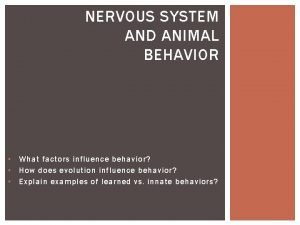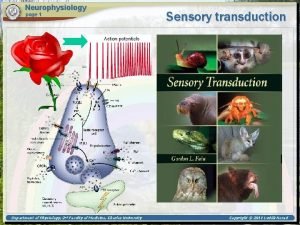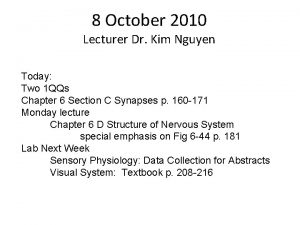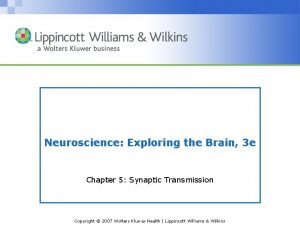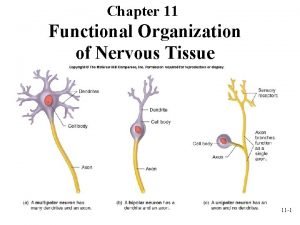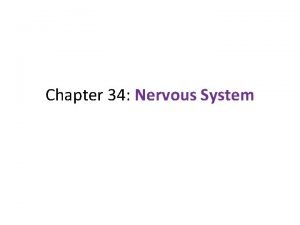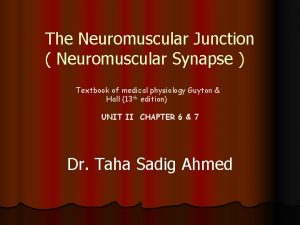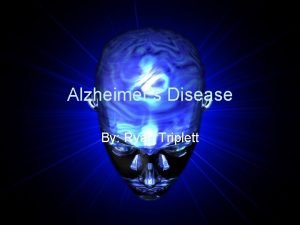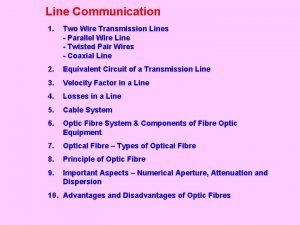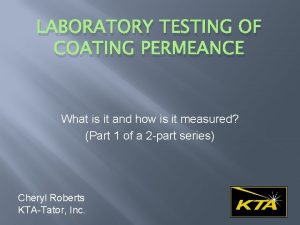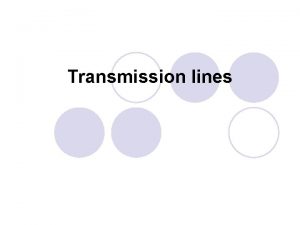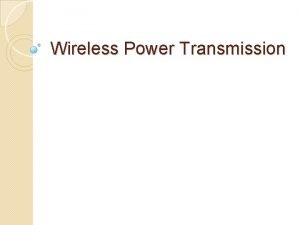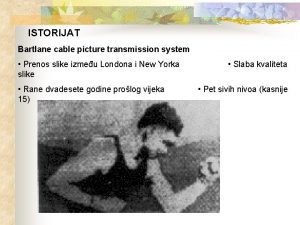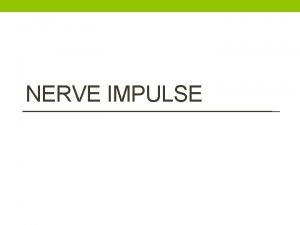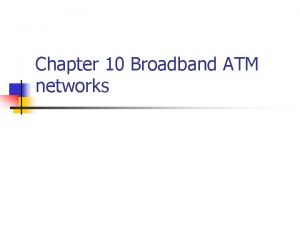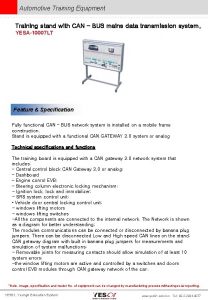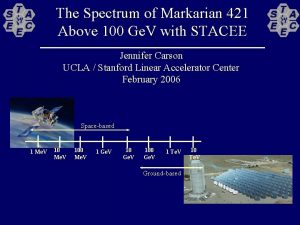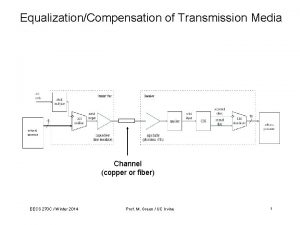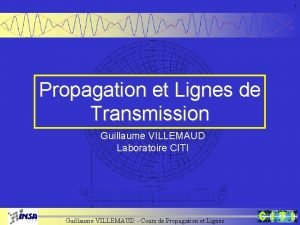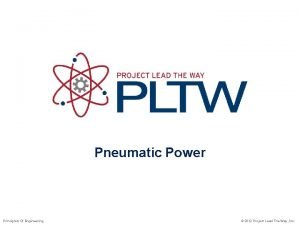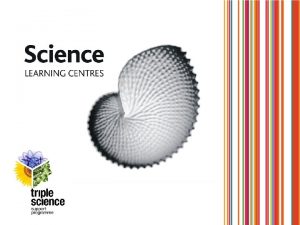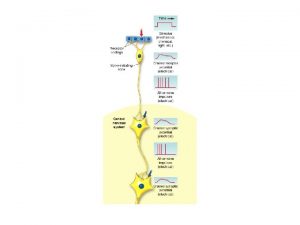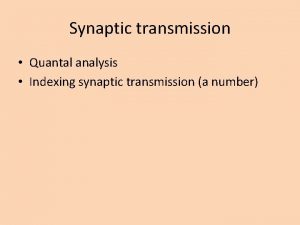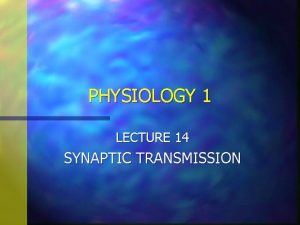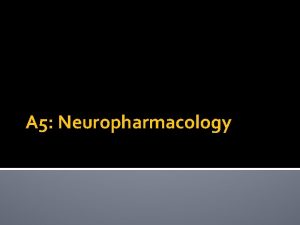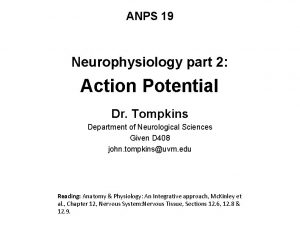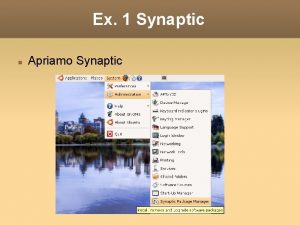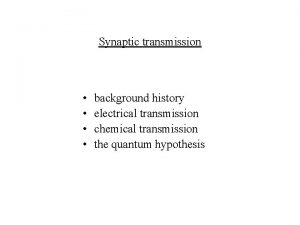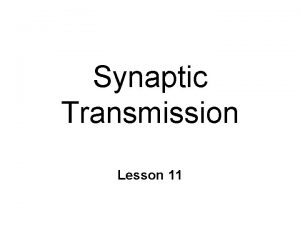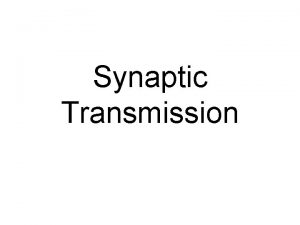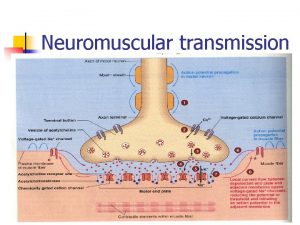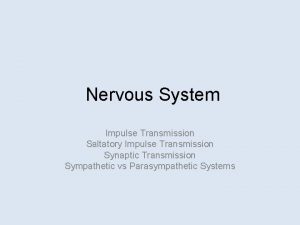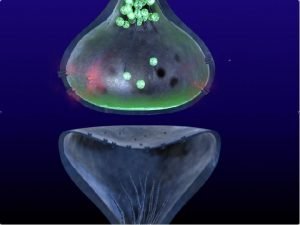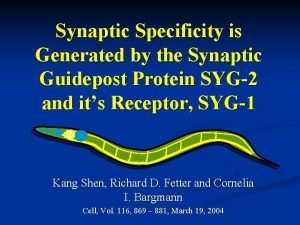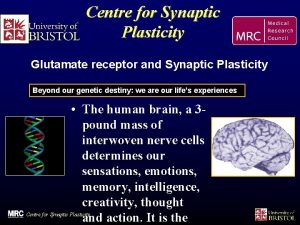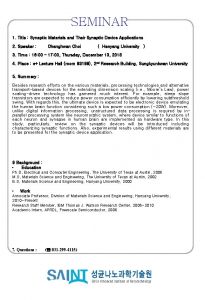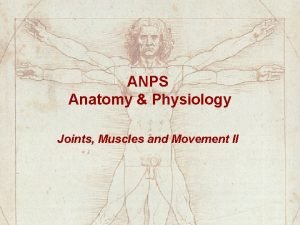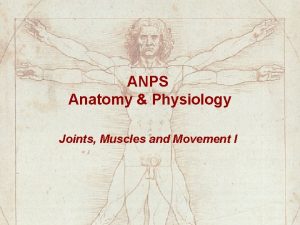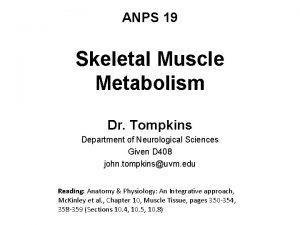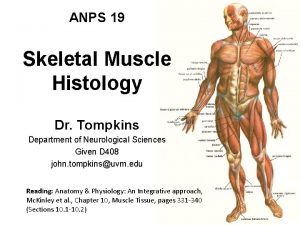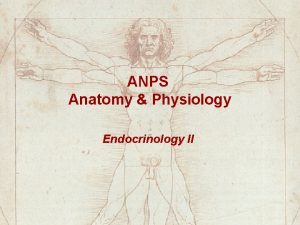ANPS 19 Neurophysiology part 3 Synaptic Transmission Dr






































- Slides: 38

ANPS 19 Neurophysiology part 3: Synaptic Transmission Dr. Tompkins Department of Neurological Sciences Given D 408 john. tompkins@uvm. edu Reading: Anatomy &Physiology: An Integrative approach, Mc. Kinley et al. , Chapter 12, Nervous System: Nervous Tissue, Section 12. 8

Now to make the model look more like a neuron. + will represent K+ ions, + will represent Na+ ions, and - will represent Cl- ions. Also, most of the anion charge inside cells is fixed, to proteins or larger molecules, and cannot move out. This is shown as -. + - - - + + + - + + in - + V voltmeter - + - + + + - - + - + Na+/K+-ATPase pump + K+ leak channel + There are more of these channels in the membrane and they contributes the most to the resting membrane potential (RMP). There are few of these channels. Na+ leak channel out chemical gradients + electrical gradients In this scenario, the potential difference in charge between inside and outside, or the resting membrane potential, is set by the separation of charge due to a diffusion of potassium out of the cell (down its chemical gradient) and a small leak of sodium into the cell (down its chemical and electrical gradients). On the next slide we’ll discuss what the actual potential is in m. V. 2

Generation of an Action Potential 1 2 3 4 1 5 +30 2 +10 3 0 m. V – 10 – 30 4 – 50 Threshold – 70 – 90 Resting membrane potential 5 0 1 Time (msec) 2 3 The unstimulated axon has a resting membrane potential of – 70 m. V. Graded potentials reach axon hillock and are added together. Depolarization phase of action potential occurs when the threshold (– 55 m. V) is reached; voltagegated Na+ channels open and Na+ enters rapidly, reversing the polarity from negative to positive (– 55 m. V +30 m. V). Repolarization phase of the action potential occurs due to closure of voltage-gated Na+ channels (inactivation state) and opening of voltage-gated K + channels. K+ moves out of the cell into the interstitial fluid and polarity is reversed from positive to negative (+30 m. V – 70 m. V). Hyperpolarization phase of the action potential occurs when voltage-gated K + channels stay open longer than the time needed to reach the resting membrane potential; during this time the membrane potential is less than the resting membrane potential of – 70 m. V.

Propagation of the Action Potential 1 1) action potential first generated in axon hillock, then 2) action potential propagated down axon 2

The neuronal membrane can be broken into 4 functional segments. The function of each segment is dictated by the type of ion channels expressed in those regions. Fig. 12. 14 axon (definition of hillock – a small hill) axon hillock Neurotransmitter Propagation of action potential Initial segment Receptive segment Binding of neurotransmitter released from presynaptic neuron; production of graded potentials Summation of graded potentials; initiation of action potential Conductive segment Propagation of action potential Transmissive segment Action potential causes release of neurotransmitter 5 Now we will discuss these two segments.

Anatomy of the Synapse • two type of synapses : chemical and electrical • this is a chemical synapse neurofilaments microtubules synaptic knob/bouton/terminal presynaptic membrane synaptic cleft mitochondria postsynaptic membrane (i. e. muscle, nerve or gland) 6

Electrical vs Chemical Synapse electrical synapse • uncommon • found in limited regions of brain and eyes chemical synapse • most common • in CNS and PNS

Receptive segment Chemically gated cation gated K+ gated Cl– channel (b) Cell body Distribution of Pumps and Channels in the Plasma Membrane of a Neuron (Figure 12. 11) Dendrites Axon hillock Initial segment Voltage-gated K+ channel Na+/K+ Na+ leak K+ leak pump channel (c) Conductive segment Entire neuron Voltage-gated Na+ channel K+ channel Axon (d) Transmissive segment Voltage-gated Ca 2+ pump Ca 2+ channel (a) Synaptic bulb (e) we’re here 8

Voltage-gated Ca 2+-channel 1. opened by depolarization 2. allows calcium into cell Concentration gradient maintained by calcium-pumps and intracellular buffers Na+ (10 m. M) Na+ (145 m. M) Cl- (20 m. M) Cl- (110 m. M) Ca++ (0. 0001 m. M) Ca++ (2 m. M) K+ (140 m. M) K+ (5 m. M) inside outside 9

Basic steps of synaptic transmission Synaptic cleft 2. Voltage-gated Ca 2+ channels open and Ca 2+ enters the synaptic terminal and binds with proteins of synaptic vesicles. Ca 2+ + ++ + Receptor ++ 1. Action potential reaches synaptic terminal. ++ + 3. Synaptic vesicles merge with synaptic terminal plasma membrane and neurotransmitter is released by exocytosis. Voltage-gated Ca 2+ channels 4. Neurotransmitter crosses synaptic cleft and attaches to receptors on post-synaptic membrane. Ca 2+ Fig. 12. 21 a Neurotransmitter Synaptic terminal Synaptic vesicle (contains neurotransmitter) 10

Anatomy of a Synaptic Vesicle (40 n. M dia. ) Synaptic cleft Synaptic vesicles Muscle cell Synaptic knob Proteins associated with a synaptic vesicle Release of synaptic vesicles can be modulated by the proteins associated with the vesicle 11

12

Basic steps of synaptic transmission Synaptic cleft 2. Voltage-gated Ca 2+ channels open and Ca 2+ enters the synaptic terminal and binds with proteins of synaptic vesicles. Ca 2+ + ++ + Receptor ++ 1. Action potential reaches synaptic terminal. ++ + 3. Synaptic vesicles merge with synaptic terminal plasma membrane and neurotransmitter is released by exocytosis. Voltage-gated Ca 2+ channels 4. Neurotransmitter crosses synaptic cleft and attaches to receptors on post-synaptic membrane. Ca 2+ Fig. 12. 21 a Neurotransmitter Synaptic terminal Synaptic vesicle (contains neurotransmitter) 13

Removal of neurotransmitters from the synaptic cleft • • • 1. Temporary association between neurotransmitter and receptor Necessary to eliminate molecule after stimulation Removal occurs by two major mechanisms Occurs by degradation - neurotransmitter chemically inactivated in synaptic cleft - e. g. , breakdown of ACh by acetylcholinesterase 2. Occurs by reuptake - neurotransmitter reabsorbed by transport protein in presynaptic neuron - “recycled” into another synaptic vesicle for reuse 14

Basic Steps in Synaptic Transmission 1) Action potential propagated down axon to synaptic terminal 2) Action potential opens voltage-gated Ca 2+ channels allowing calcium ions to move into the synaptic terminal and bind to synaptic vesicle proteins 3) Vesicles fuse with the neuronal plasma membrane and neurotransmitter is released into the synaptic cleft by exocytosis 4) Neurotransmitter binds to specific post-synaptic receptors (chemically-gated ion channels) 15

Neurotransmitters • Classes of neurotransmitters – – – Neurotransmitters, various small organic compounds Released at synaptic cleft Approximately 100 known Classified into major groups Can be either excitatory (causing depolarization of the membrane) or inhibitory (causing hyperpolarization of the membrane) – Neurons typically release one type of transmitter and are named accordingly (i. e. cholinergic) 16

Neurotransmitters and Neuromodulation • Classes of neurotransmitters (continued) – Acetylcholine (cholinergic neuron) • excitatory or inhibitory neurotransmitter • released in both CNS and PNS • molecule released from motor neuron at neuromuscular junction – Amino acids • building blocks of proteins • some also neurotransmitters • e. g. , glutamate, glycine, GABA 17

Neurotransmitters and Neuromodulation • Classes of neurotransmitters (continued) – Monoamines • derived from certain amino acids • carboxyl group removed and functional group added • subgroup added determines type • includes subgroup, catecholamines (norepinephrine, dopamine) – Neuropeptides • chains of amino acids • include enkephalins and somatostatin See Table 12. 4: Neurotransmitters 18

19

Basic steps of synaptic transmission Synaptic cleft 2. Voltage-gated Ca 2+ channels open and Ca 2+ enters the synaptic terminal and binds with proteins of synaptic vesicles. Ca 2+ + ++ + Receptor ++ 1. Action potential reaches synaptic terminal. ++ + 3. Synaptic vesicles merge with synaptic terminal plasma membrane and neurotransmitter is released by exocytosis. Voltage-gated Ca 2+ channels 4. Neurotransmitter crosses synaptic cleft and attaches to receptors on post-synaptic membrane. Ca 2+ Fig. 12. 21 a Neurotransmitter Synaptic terminal Synaptic vesicle (contains neurotransmitter) 20

Acetylcholine and other Neurotransmitters can produce graded potentials on neurons! Example of an ionotropic receptor 21

Example of an metabotropic receptor 22

Receptive segment Chemically gated cation gated K+ gated Cl– channel (b) Cell body Distribution of Pumps and Channels in the Plasma Membrane of a Neuron (Figure 12. 11) now we’re here Dendrites Axon hillock Initial segment Voltage-gated K+ channel Na+/K+ Na+ leak K+ leak pump channel (c) Conductive segment Entire neuron Voltage-gated Na+ channel K+ channel Axon (d) Transmissive segment Voltage-gated Ca 2+ pump Ca 2+ channel (a) Synaptic bulb (e) 23

Chemically-gated Ion Channels • normally closed • opened by very specific molecule (i. e. ligand/ neurotransmitter) think “lock & key” • allows specific ions to diffuse when open • chemical energy transduced into physical energy Closed Open Neurotransmitter binds and opens gate K+ (c) Chemically gated channels (Figure 12. 10 c) 24

Introduction to Neuron Physiology: Changing the Membrane Potential When the post-synaptic receptors are activated a graded potential is produced at the post-synaptic membrane. A graded potential is a small change in membrane potential that can be either hyperpolarizing or depolarizing. 25

Introduction to Neuron Physiology: Changing the Membrane Potential Graded potentials versus action potentials • Graded potentials – May result in depolarization or hyperpolarization • depends on channel that opens – Degree dependent on stimulus magnitude – not all or none • larger stimulus opening more chemically gated channels • flow of more ions – Decreases in intensity with distance along the membrane – Short-lived • lasts until local ion current ceases 26

27

Release of Excitatory Neurotransmitter and Generation of EPSP (Figure 12. 15 a) Axons of presynaptic neuron Postsynaptic neuron Release of excitatory neurotransmitter and generation of EPSP 1 Axons of presynaptic neuron Excitatory neurotransmitter released from presynaptic neuron binds to receptors, which are chemically gated cation channels, causing them to open. Excitatory neurotransmitter Postsynaptic neuron 0 Chemically gated cation channel 2 Na+ flows into neuron. Na+ 3 Inside of neuron becomes more positive (less negative); called EPSP (e. g. , – 68 m. V). Synaptic vesicles containing excitatory neurotransmitter – 20 Voltage (m. V) Synaptic knob – 40 EPSP Threshold – 60 4 EPSP propagates toward axon hillock. Stimulus – 70 Resting membrane potential – 80 Time (msec) (a) Synaptic cleft 28

Physiologic Events in the Neuron Segments: Receptive Segment Generation of EPSPs • Sequence of events 1) Excitatory neurotransmitter crosses synaptic cleft. • binds to receptor • opens a chemically gated cation channel 2) More Na+ moves into neuron than K+ moves out. 3) Inside becomes slightly more positive (depolarized). • less negative state called excitatory postsynaptic potential (EPSP) 4) Local current of Na+ becomes weaker • decreases in intensity with distance traveled 29

Physiologic Events in the Neuron Segments: Receptive Segment • Generation of EPSPs (continued) – Degree of change in RMP • dependent on amount of neurotransmitter bound per unit time – More excitatory neurotransmitter released • more cation channels open • greater change in the positive direction 30

Release of Inhibitory Neurotransmitter and Generation of IPSP (Figure 12. 15 b) Release of inhibitory neurotransmitter and generation of IPSP 1 Axons of presynaptic neuron Inhibitory neurotransmitter binds to either chemically gated K + channels or chemically gated Cl– channels, causing them to open. Inhibitory neurotransmitter Postsynaptic neuron 0 Chemically gated K + channel Chemically gated Cl – channel – 20 2 Either K+ flows out of, or Cl– flows into, the neuron, depending on the type of channel stimulated. K+ Cl– 3 Inside of neuron becomes more negative; called IPSP (e. g. , – 72 m. V). Voltage (m. V) Synaptic vesicles containing inhibitory neurotransmitter – 40 Threshold – 60 Cl– Stimulus 4 IPSP propagates toward axon hillock. – 70 – 80 IPSP Resting membrane potential Time (msec) (b) 31

Physiologic Events in the Neuron Segments: Receptive Segment Generation of IPSPs • Sequence of events 1) Inhibitory neurotransmitter crosses synaptic cleft. • binds to chemically gated K+ channel or Cl- channel • depends on neurotransmitter and channels present 2) If neurotransmitter gates K+ channel, K+ moves out of neuron. If neurotransmitter binds Cl-channel, Cl- flows into neuron. 3) Inside of the cell becomes slightly more negative 1)more negative state termed inhibitory postsynaptic potential (IPSP) 4) Local current of ions becomes weaker. • decreases in intensity with distance traveled toward initial segment 32

Physiologic Events in the Neuron Segments: Receptive Segment • Simultaneous release – Excitatory and inhibitory neurotransmitters • may be simultaneously released from different neurons – Varied frequency of releasing neurotransmitter – Result: many EPSPs, many IPSPs, or both 33

Several Presynaptic Neurons with a Postsynaptic Neuron(Figure 12. 16) EPSP Postsynaptic neuron Synaptic knob Presynaptic axons Axons of presynaptic neuron Dendrites Cell body of postsynaptic neuron Myelin sheath SEM 80, 000 x IPSP Axons of presynaptic neuron 34

Physiologic Events in the Neuron Segments: Initial Segment • Summation – Addition of graded postsynaptic potentials (IPSPs and EPSPs) – Occurs at the initial segment – Determines if threshold membrane potential is reached • -55 m. V, +15 m. V from RMP – If threshold reached • voltage-gated channels open • action potential generated that travels along axon 35

Physiologic Events in the Neuron Segments: Initial Segment • Summation (continued) – Spatial summation • release of neurotransmitter from multiple presynaptic neurons • action potential initiated if enough EPSPs generated – Temporal summation • repeated release of excitatory neurotransmitter at same location • effects added if occur within small timeframe • action potential initiated if threshold reached 36

Spatial summation Membrane potential (m. V) +30 Spatial Summation at the Axon Hillock (Figure 12. 7 a) Initial segment Action potential 0 – 55 P 1 P 4 P 2 P 3 P 5 Threshold Axon hillock – 70 Time (m sec) Dendrites Cell body of postsynaptic neuron P 1 P 2 Myelin sheath P 3 EPSPs P 4 P 5 Axons of presynaptic neurons (P 1–P 5) (a) Spatial summation 37

Temporal summation +30 Membrane potential (m. V) Temporal Summation at the Axon Hillock (Figure 12. 7 b) Action potential 0 P 2 Threshold – 55 – 70 Time (m sec) Axon of presynaptic neuron (P 2) Postsynaptic neuron P 2 EPSPs (b) Temporal summation Axon 38
 Tapetum lucidum
Tapetum lucidum Neurophysiology
Neurophysiology Sentience
Sentience Synaptic gutter
Synaptic gutter Synaptic integration
Synaptic integration Lippincott williams & wilkins
Lippincott williams & wilkins Screenless display technology ppt
Screenless display technology ppt Synaptic potential
Synaptic potential Synaptic integration
Synaptic integration Neuromuscular transmission steps
Neuromuscular transmission steps Thin filament
Thin filament Ryan triplett
Ryan triplett Bar parts and equipment
Bar parts and equipment Part part whole addition
Part part whole addition The part of a shadow surrounding the darkest part
The part of a shadow surrounding the darkest part Unit ratio definition
Unit ratio definition Part to part variation
Part to part variation Technical description
Technical description Part part whole
Part part whole Parallel wire transmission line
Parallel wire transmission line Ercot
Ercot Types of synapse
Types of synapse Define permeance
Define permeance X-linked dominant
X-linked dominant Transmission line velocity
Transmission line velocity Air ionization in wireless power transmission
Air ionization in wireless power transmission Bartlane cable picture transmission system
Bartlane cable picture transmission system Contact transmission
Contact transmission Nerve impulse steps with pictures
Nerve impulse steps with pictures Chapter 19 disease transmission and infection prevention
Chapter 19 disease transmission and infection prevention Support de transmission
Support de transmission Automobile data transmission system can bus training stand
Automobile data transmission system can bus training stand Markarian 421 transmission
Markarian 421 transmission Transmission medias
Transmission medias Data encoding and modulation
Data encoding and modulation Guillaume villemaud
Guillaume villemaud Pneumatic power transmission
Pneumatic power transmission Central area transmission system
Central area transmission system Mobile ka
Mobile ka
